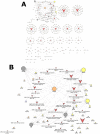This is a preprint.
A Workflow of Integrated Resources to Catalyze Network Pharmacology Driven COVID-19 Research
- PMID: 33173863
- PMCID: PMC7654851
- DOI: 10.1101/2020.11.04.369041
A Workflow of Integrated Resources to Catalyze Network Pharmacology Driven COVID-19 Research
Update in
-
A Workflow of Integrated Resources to Catalyze Network Pharmacology Driven COVID-19 Research.J Chem Inf Model. 2022 Feb 14;62(3):718-729. doi: 10.1021/acs.jcim.1c00431. Epub 2022 Jan 20. J Chem Inf Model. 2022. PMID: 35057621 Free PMC article.
Abstract
Motivation: In the event of an outbreak due to an emerging pathogen, time is of the essence to contain or to mitigate the spread of the disease. Drug repositioning is one of the strategies that has the potential to deliver therapeutics relatively quickly. The SARS-CoV-2 pandemic has shown that integrating critical data resources to drive drug-repositioning studies, involving host-host, hostpathogen and drug-target interactions, remains a time-consuming effort that translates to a delay in the development and delivery of a life-saving therapy.
Results: Here, we describe a workflow we designed for a semi-automated integration of rapidly emerging datasets that can be generally adopted in a broad network pharmacology research setting. The workflow was used to construct a COVID-19 focused multimodal network that integrates 487 host-pathogen, 74,805 host-host protein and 1,265 drug-target interactions. The resultant Neo4j graph database named "Neo4COVID19" is accessible via a web interface and via API calls based on the Bolt protocol. We believe that our Neo4COVID19 database will be a valuable asset to the research community and will catalyze the discovery of therapeutics to fight COVID-19.
Availability: https://neo4covid19.ncats.io.
Conflict of interest statement
Competing Interests
LJJ is co-founder and scientific advisory board member of Intomics A/S. All other authors have no competing interests to declare.
Figures



References
Publication types
Grants and funding
LinkOut - more resources
Full Text Sources
Miscellaneous
